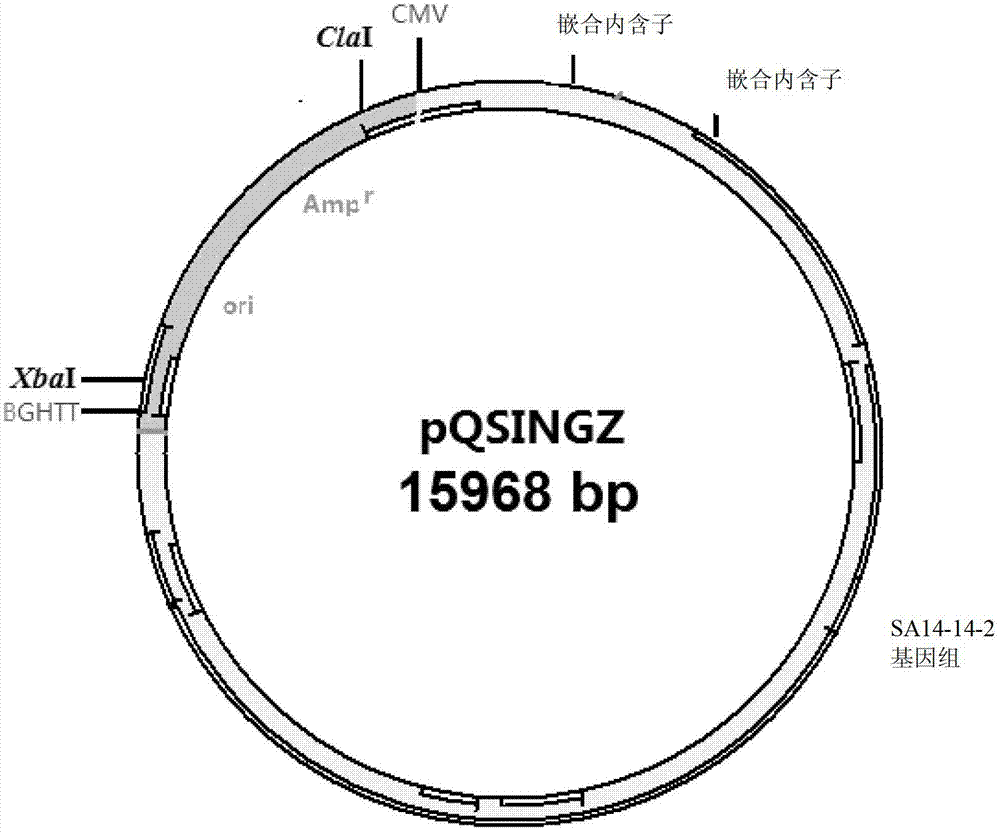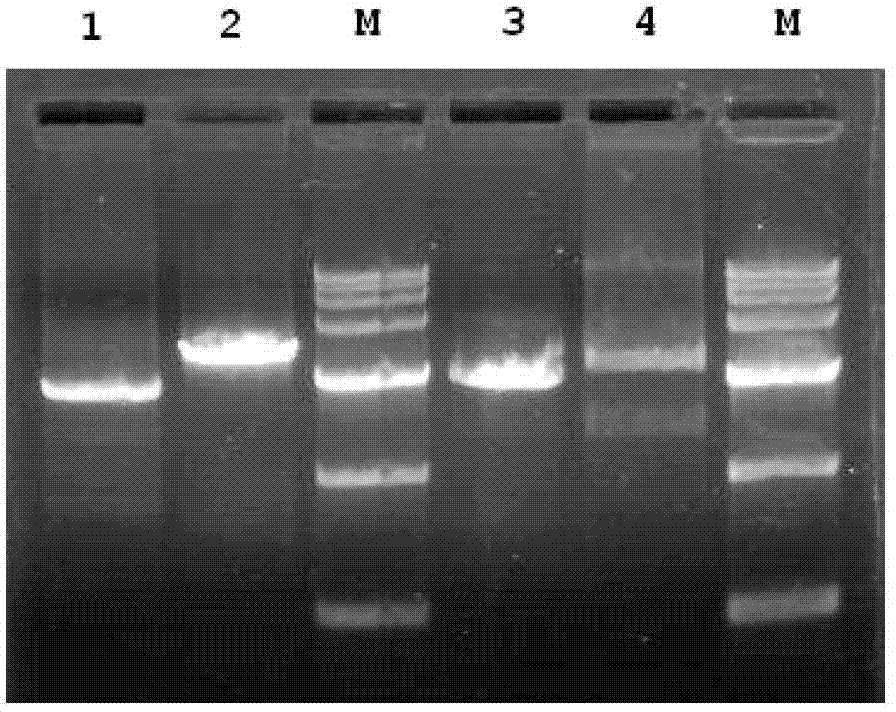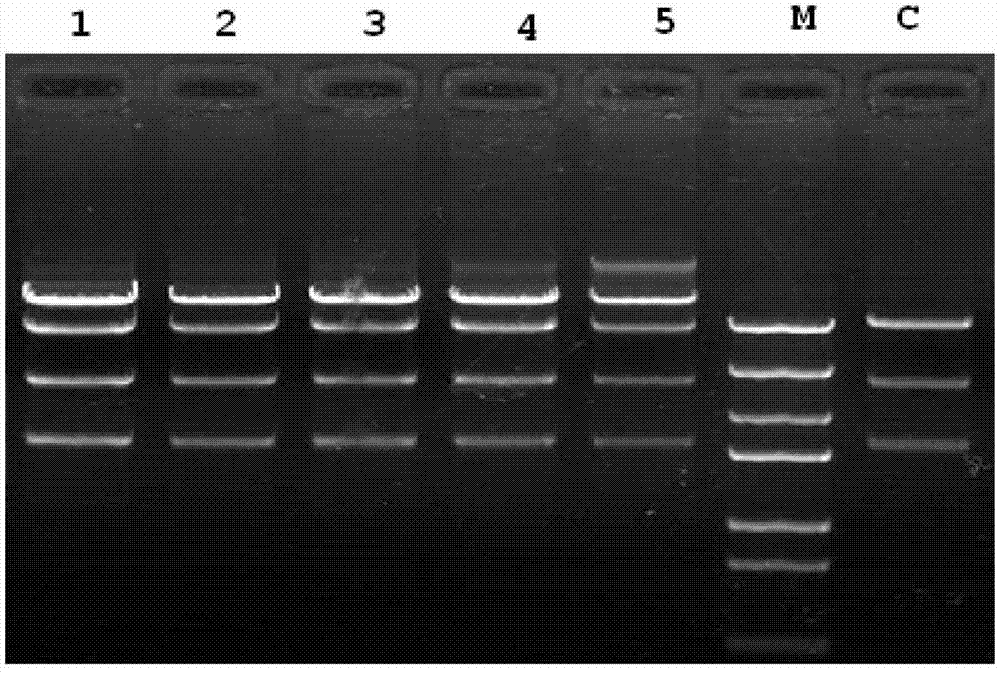DNA (Deoxyribose Nucleic Acid)-based infectious clone of a Japanese encephalitis virus SA14-14-2 strain, as well as construction method and application thereof
An infectious cloning, encephalitis virus technology, applied in the field of reverse genetics technology and RNA virus rescue, can solve problems that have not yet been seen, and achieve good infectivity
- Summary
- Abstract
- Description
- Claims
- Application Information
AI Technical Summary
Problems solved by technology
Method used
Image
Examples
Embodiment 1
[0048] Genome sequence identification of embodiment 1 Japanese encephalitis virus vaccine strain SA14-14-2
[0049] 1. Obtaining Genome RNA of Live Attenuated Vaccine SA14-14-2 Strain Virus
[0050] (1) Take a freeze-dried preparation of Japanese encephalitis live attenuated vaccine (batch number 200710049-2, SA14-14-2 virus content: 5.4 lgPFU), add 0.5mL virus diluent to reconstitute.
[0051] (2) Extraction of viral genome RNA: Add 0.8ml Trizol reagent to 0.5ml vaccine diluent, mix well, and let stand at room temperature for 5 minutes; add 0.2ml chloroform, mix well, let stand at room temperature for 5 minutes; centrifuge at 4°C, 12000g×20min.
[0052] (3) Take the upper aqueous phase, transfer it to a new centrifuge tube free from RNase contamination, add an equal volume of isopropanol for extraction, and let stand at room temperature for 10 minutes. Centrifuge at 4°C, 12000g×20min.
[0053] (4) Discard the supernatant, add 0.5ml of 75% alcohol to rinse, mix well and let...
Embodiment 2
[0066] Example 2 Transformation of RNA-based JEV infectious clones into DNA-based JEV infectious clones
[0067] 1. Transformation of Genome 5' Half Molecule Cloning of SA14-14-2 Vaccine Strain
[0068] Plasmid pBRKpn-J1J2 (Ying, H., 2003) is the 5' semi-molecular clone of the SA14-14-2 vaccine strain, including the 1-5581 nucleotide sequence of the genome. On this basis, the CMV sequence was merged by fusion PCR technology (SEQ ID NO: 27) was fused with the 5' end sequence of the SA14-14-2 genome, cloned into the plasmid vector pBRKpn-J1J2 through the MluI and ClaI restriction sites, and the two chimeric introns were further combined by fusion PCR technology The sequence (SEQ ID NO: 28) was inserted into the JEV genome at positions 356 and 2217 to construct plasmid pCMV-J1J2. In addition, according to the sequencing results in Table 1, site-directed back-mutation was performed on individual nucleotide mutations present on the plasmid pCMV-J1J2.
[0069] 2. Transformation o...
Embodiment 3
[0083] Example 3 Evaluation of the infectivity of SA-14-14-2DNA-based full-length clone pQSINGZ at the cell level
[0084] In order to evaluate the infectivity of the SA-14-14-2DNA-based full-length clone in vitro, the purified plasmid was transfected into BHK-21 cells, and the production of recovered virus was observed.
[0085] (1) Purification and transfection of pQSINGZ-EG
[0086] The SA14-14-2 full-length clone plasmid pQSINGZ-EG containing the reporter gene EGFP was extracted and purified with the Plasmid Max Kit (Plasmid Max Kit, Qiagen Company), and the concentration of the plasmid was adjusted to 1 μG / μL. Lipofectamine TM 2000, Invitrogen Company) method to transfect BHK-21 cells, every 24 hours after transfection, observe and record under the fluorescence microscope ( Figure 6 ).
[0087] (2) Purification and transfection of pQSINGZ
[0088] The SA14-14-2 full-length cloning plasmid pQSINGZ was extracted and purified with the Plasmid Max Kit (Plasmid Max Kit, Q...
PUM
 Login to View More
Login to View More Abstract
Description
Claims
Application Information
 Login to View More
Login to View More - R&D
- Intellectual Property
- Life Sciences
- Materials
- Tech Scout
- Unparalleled Data Quality
- Higher Quality Content
- 60% Fewer Hallucinations
Browse by: Latest US Patents, China's latest patents, Technical Efficacy Thesaurus, Application Domain, Technology Topic, Popular Technical Reports.
© 2025 PatSnap. All rights reserved.Legal|Privacy policy|Modern Slavery Act Transparency Statement|Sitemap|About US| Contact US: help@patsnap.com



